






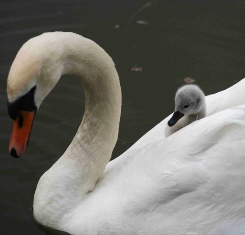
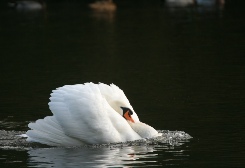
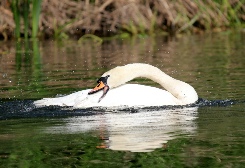
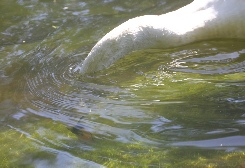
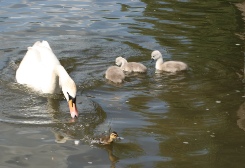
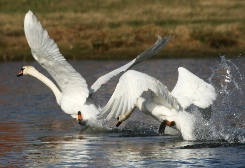
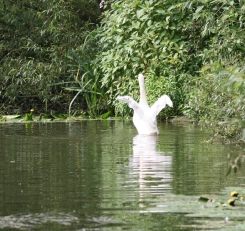
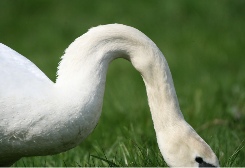
Mating Behaviour
Courtship is initially identified by mutual head bobbing by the male and female. They will often begin to swim beside each other dipping their heads lower and lower.
Once the female assumes the position with her head very low and outstretched the male will mount her and copulation will take place.
With mating over the pair perform a dance perhaps to reinforce the bonding. The pair will begin to entwine their necks often forming a heart shape. Then the will beat their feet to rise out of the water. This is sometimes accompanied by snorting noises.
The pair then separate and both sexes take part in extensive preening.

Feeding Behaviour
Swans eat mostly eel grass, aquatic vegetation and some invertebrates. They do this by using their long necks to probe and sift for food. To get extra depth they often up end like ducks.
Swans are also partial to grass and cereal crops and can be seen in fields feasting on tender shoots or seed heads.
Aggressive Behaviour
Mute Swans are very territorial and due to this can be very aggressive. They will fight defend a nest, territory or any perceived threat to them or their young. The standard aggression posture is one with the neck pulled back and low with the wings fluffed up into an arc.
When challenging other swans they will often swim alongside each other on the border as if sizing each other up. One will then swim at the other with jerky powerful beats of the feet. If this doesn’t work the aggressor will move in closer by flying low and beating its wings. Actually fighting involves biting and snorting.
It has been known for Adult swans to kill other swans who they see as rivals and to attack their own offspring when it is time for them to move on and find their own territory. When with young both sexes can be highly aggressive and will often attack other river users and waterfowl.
Moulting
In the summer of each year birds will go into ‘pin’, shedding their flight feathers and letting new ones to grow. They do this when they have young and so couldn’t fly away anyway's. It does make them vulnerable however and so they often group together and communal sites
Taxi-
With young cygnets mothers can sometimes be seen giving them lifts up to 2-
It is possible that they allow them to do this whilst roosting at night on water or to rest tired young.